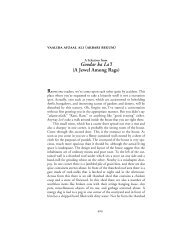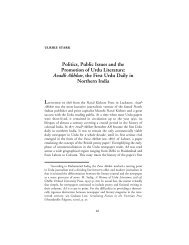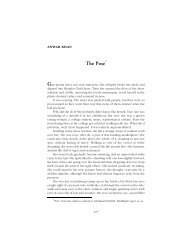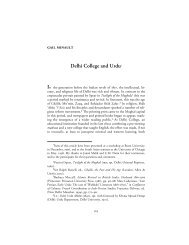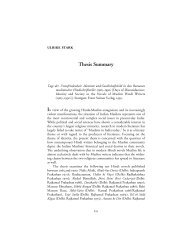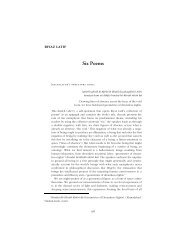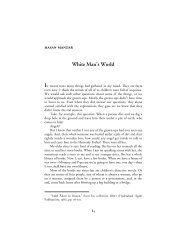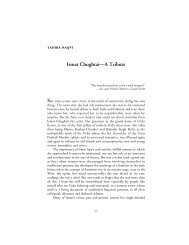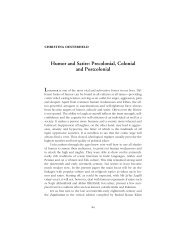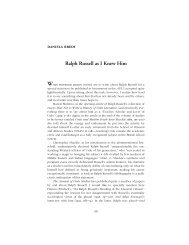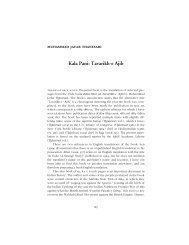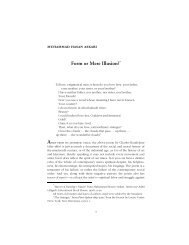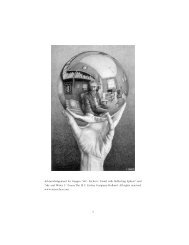Echoes and Exuberances: Baidar Bakht's Recent Translations of ...
Echoes and Exuberances: Baidar Bakht's Recent Translations of ...
Echoes and Exuberances: Baidar Bakht's Recent Translations of ...
You also want an ePaper? Increase the reach of your titles
YUMPU automatically turns print PDFs into web optimized ePapers that Google loves.
CARLO COPPOLA<strong>Echoes</strong> <strong>and</strong> <strong>Exuberances</strong>: <strong>Baidar</strong> Bakht’s<strong>Recent</strong> <strong>Translations</strong> <strong>of</strong> Urdu PoetryTHE MOST PROLIFIC, <strong>and</strong> possibly the most gifted, translator <strong>of</strong> Urdupoetry into English these days is, no doubt, <strong>Baidar</strong> Bakht <strong>of</strong> Toronto, aspecialist not in Urdu literature as one might expect, but rather in bridgeengineering, a subject in which he holds a University <strong>of</strong> London D.Sc.One first noted his considerable talents as a translator in An Anthology <strong>of</strong>Modern Urdu Poetry (Delhi: Educational Publishing House, 1984) whichhe edited in collaboration with the Canadian poet Kathleen Grant Jaeger.Here, all renderings show Bakht <strong>and</strong> Jaeger to be deft <strong>and</strong> sensitivetranslators <strong>of</strong> the many “exuberances” <strong>of</strong> Urdu poetry into English. 1One cannot help but compare this anthology to Mahmood Jamal’sThe Penguin Book <strong>of</strong> Modern Urdu Poetry (Harmondsworth, Engl<strong>and</strong>:Penguin, 1986) which features one hundred poems by seventeen poets. Aswould be expected, there is some overlap <strong>of</strong> poets <strong>and</strong> poems in eachvolume. Both anthologies have individual merits <strong>and</strong> defects: (1) Jamal’svolume presents breadth, Bakht’s depth; (2) Jamal, an English-languagepoet working alone, has produced translations whose surface textures1 The term “exuberance” (an artistic feature found in the original text <strong>and</strong>/ormaintained in the translation) <strong>and</strong> its opposite, “deficiency” (the lack <strong>of</strong> a givenartistic feature in the original <strong>and</strong>/or in the translation), are based on notions <strong>of</strong>José Ortega y Gasset developed in his 1934 essay “The Misery <strong>and</strong> Splendor <strong>of</strong>Translation,” for which see, Theories <strong>of</strong> Translation: An Anthology <strong>of</strong> Essays fromDryden to Derrida, ed. Reiner Schulte <strong>and</strong> John Biguenet (Chicago: University <strong>of</strong>Chicago Press, 1992), pp. 93–112. Pr<strong>of</strong>essor A.L. Becker’s lucid discussions <strong>of</strong>these concepts during the NEH institute, “Modern Southeast Asian Literature inTranslation,” which took place at the University <strong>of</strong> Michigan, Ann Arbor, in thesummer <strong>of</strong> 1992, were extremely helpful in underst<strong>and</strong>ing these ideas.142
CARLO COPPOLA • 143strike one as being less varied than those found in the collaborative effort<strong>of</strong> Bakht <strong>and</strong> Jaeger; 2 (3) the availability <strong>of</strong> the Urdu original opposite thetranslation allows for both playful <strong>and</strong> serious comparisons <strong>of</strong> the two,<strong>and</strong> is a highly desirable feature <strong>of</strong> the Bakht-Jaeger anthology; <strong>and</strong> (4)the extensive distribution <strong>and</strong> ready availability <strong>of</strong> Penguin booksgenerally, <strong>and</strong> Jamal’s anthology in particular, will bring tens <strong>of</strong>thous<strong>and</strong>s <strong>of</strong> English-language readers to Urdu literature for the firsttime.<strong>Baidar</strong> Bakht <strong>and</strong> his associates have since this anthology producedfive volumes <strong>of</strong> translated poems by individual poets, <strong>and</strong> in what followsI shall review <strong>and</strong> discuss them individually, roughly according to theirdate <strong>of</strong> publication. 31. Balraj Komal was born in 1928 in Sialkot, Punjab, <strong>and</strong> teachesEnglish at Delhi University. The author <strong>of</strong> eight volumes <strong>of</strong> poetry inUrdu <strong>and</strong> Hindi, as well as a volume <strong>of</strong> Urdu short stories <strong>and</strong> a volume<strong>of</strong> criticism in Urdu, he has received numerous awards, including thosegiven by the Uttar Pradesh Academy, the Mir Academy (Lucknow), theMinistry <strong>of</strong> Education (Government <strong>of</strong> India), <strong>and</strong> the Delhi Urdu2 I have suggested elsewhere that Jamal’s renderings <strong>of</strong> Faiz bear an uncannyresemblance to those <strong>of</strong> Victor Kiernan in Poems <strong>of</strong> Faiz (London: George Allen& Unwin, 1971). See my “The Language <strong>of</strong> Faiz <strong>and</strong> His English Translators,”South Asia (Australia), 14:2 (December 1992), which discusses five differenttranslators’ renderings <strong>of</strong> Faiz’s poems.3 They are: (1) Balraj Komal, Selected Poems <strong>of</strong> Balraj Komal; edited by <strong>Baidar</strong>Bakht; introduction by Shamsur Rahman Faruqi; translated by Leslie Lavigne<strong>and</strong> <strong>Baidar</strong> Bakht (Delhi: Educational Publishing House; Toronto: UrduPublications, 1989; 113 pp.; Rs. 40/-; US $7.00; bilingual texts); (2) Shahryar, TheGateway to Dreams is Closed; translated by <strong>Baidar</strong> Bakht <strong>and</strong> Leslie Lavigne (NewDelhi: Sahitya Akademi, 1990; 120 pp.; Rs. 25/-); (3) Akhtar-ul-Iman, TakingStock: Selected Poems <strong>of</strong> Akhtar-ul-Iman; foreword by the poet; edited by <strong>Baidar</strong>Bakht; translated by <strong>Baidar</strong> Bakht, Leslie Lavigne, <strong>and</strong> Kathleen Grant Jaeger(Lahore: Sang-e-Meel Publications, 1991; 146 pp.; Rs. 90/-); (4) Amjad IslamAmjad, In the Last Days <strong>of</strong> Autumn: Selection <strong>of</strong> Poems <strong>of</strong> Amjad Islam Amjad;selected by <strong>Baidar</strong> Bakht; translated by <strong>Baidar</strong> Bakht <strong>and</strong> Leslie Lavigne (Lahore:Sang-e-Meel Publications, 1991; 66 pp.; Rs. 90/-); <strong>and</strong> (5) Kishwar Naheed, TheScream <strong>of</strong> an Illegitimate Voice: Selection <strong>of</strong> Poems <strong>of</strong> Kishwar Naheed; selected by<strong>Baidar</strong> Bakht; translated by <strong>Baidar</strong> Bakht, Leslie Lavigne, <strong>and</strong> Derek M. Cohen(Lahore: Sang-e-Meel Publications, 1991; 166 pp.; Rs. 90/-).
144 • THE ANNUAL OF URDU STUDIESAcademy. Komal also won the prestigious Sahitya Akademi Urdu prize in1985 for his collection Parindå B^ar≥ ¥sm≥n (Sky Full <strong>of</strong> Birds).In his introduction to Selected Poems <strong>of</strong> Balraj Komal, which containsthirty-three translations drawn from Komal’s various collections, criticShamsur Rahman Faruqi notes that Balraj is the poet’s single given name,<strong>and</strong> Komal, meaning “gentle” or “tender,” his pen name. Komal’s poetry,continues Faruqi, is “gentle, <strong>of</strong>ten understated, <strong>of</strong>ten complex <strong>and</strong>ambiguous. Sometimes puzzled <strong>and</strong> questioning, sometimes sad <strong>and</strong>lonely <strong>and</strong> occasionally rapturous, especially when he contemplates theantics <strong>of</strong> little children” (p. 1).Many <strong>of</strong> Komal’s poems feature children as personae, depict the“innocent” world <strong>of</strong> children, or use children’s seemingly unaffectedwords as both perspicacious <strong>and</strong> perspicuous commentaries on the humancondition. According to Faruqi, Komal has “an awareness <strong>of</strong> children <strong>and</strong>has a creative identification with them” (p. 2), much like Yeats.In this context Komal’s poem “The Paper Boat” (pp. 12–13) isnotable. Here the small son <strong>of</strong> the speaker, also a poet, asks his father thesame litany <strong>of</strong> answerless questions with which every parent is inflicted bya child wishing to avoid going to bed: “Why is the moon so far away?,”etc. Finally, the child falls asleep <strong>and</strong> the speaker writes a poem. The nextmorning children are happily shouting, sailing “the fleet <strong>of</strong> tiny, wobblyships” “in the lake <strong>of</strong> last night’s rain.” His son’s boat is made <strong>of</strong> “Theelusive form <strong>of</strong> the poem, / Familiar piece <strong>of</strong> paper, / Familiar words.” Ifthat isn’t enough, the child calls out, perhaps to add insult to injury,perhaps to put everything, including the ruined poem, into properperspective: “Anyone who doesn’t clap his h<strong>and</strong>s today / Is nothing but afool.”Whereas most <strong>of</strong> Komal’s poems about children are gentle <strong>and</strong>tender, several <strong>of</strong> them also contain images <strong>of</strong> extreme violence. One suchpoem entitled “A Girl Alone” (pp. 8–9), written in 1948, brought Komalimmediate literary attention. Being the period <strong>of</strong> the post-Partition riots,it is not surprising that the poem deals with a young girl victimized bythese events. She addresses a “stranger” <strong>and</strong> tells him that she has no oneleft in the world <strong>and</strong>That small home under whose shadeI listened to the melody <strong>of</strong> lullabies,Picked flowers,Sang songs,Smiled:
CARLO COPPOLA • 145Today, it is not there.Today, it is not there.She asks the stranger to “Stop for a moment” <strong>and</strong> to “Listen to thistear-soaked tale . . . ,” to “Take along this wailing made flesh.” In hopes<strong>of</strong> retrieving some tenuous connection with the world gone mad, sheentreats him to be her mamma, papa, elder sister, tiny innocent brother,the proud rays <strong>of</strong> her chastity; <strong>and</strong> in a final, desperate cri de cœur, shebegs: “Be anyone <strong>of</strong> mine, / Anyone.” The economy <strong>of</strong> the last two linesin English is simply stunning.A poem which combines both a child’s pr<strong>of</strong>ound comment <strong>and</strong> thetheme <strong>of</strong> violence is “The Long Dark Lake” (pp. 40):In that familiar town,Boys,Kids from schoolWere passing by noisily.A pious, innocent girlWas killed by her own h<strong>and</strong>sIn her own home.In the crowd <strong>of</strong> the streets,I was there too, with my motherAnd other home folks.The little one wanted me to repeat:A star shot from the skyLast nightAnd went downInto the long dark lake.The innocent child, “nann^≥,” translated here as “The little one,”who wants the speaker to repeat lines from what seems to be a folk song,is the speaker’s little son or, possibly (but not probably), his daughter.The choice <strong>of</strong> the gender-ambiguous <strong>and</strong> sex-neutral “The little one” isone <strong>of</strong> the many exuberances <strong>of</strong> the poem <strong>and</strong> allows for several readings,one <strong>of</strong> which is that a little girl is commenting on the death <strong>of</strong> anothergirl. Such a reading, with its (intended or accidental) implications <strong>of</strong>sisterhood <strong>and</strong> solidarity, exhibits more irony than if the comment weremade by a male child.The violence in this poem is the suicide <strong>of</strong> a girl who, because <strong>of</strong> thereferences to her as “pious” <strong>and</strong> “innocent,” is perhaps a new bride. The
146 • THE ANNUAL OF URDU STUDIESstar, “broken” from the sky, is a kind <strong>of</strong> “postshadowing” or mirroring <strong>of</strong>the suicide found earlier in the verse. More important, however, is the“long dark lake” where the star l<strong>and</strong>s, from which the poem takes its title.Is it the oblivion <strong>of</strong> death? Is it a kind <strong>of</strong> hell for suicides? Or is it simplyan illusion <strong>of</strong> a star observed by a child seeming to fall into a spooky,black lake? Or something else entirely? Clearly, the ambiguity <strong>of</strong> thequestions <strong>and</strong> their interpretations contribute to the complexity <strong>and</strong>quality <strong>of</strong> this poem.A distinctive feature <strong>of</strong> Komal’s poetry is his use <strong>of</strong> colors, forexample, the “yellow haze” in the poem “Your Stranger” (pp. 30–31).Yellow, <strong>and</strong> its variants in the forms <strong>of</strong> golds <strong>and</strong> reds, seem to be afavorite: not always associated with good things, <strong>and</strong> <strong>of</strong>ten with thedisappointment that comes from overreaching, achieving, <strong>and</strong> in theprocess losing something else more precious. “Saba’s H<strong>and</strong>s Are NowYellow” (pp. 35–36) is noteworthy in this context. In this poignant,wistful poem a young girl, Saba, paints her h<strong>and</strong>s as part <strong>of</strong> her weddingceremony; after a time, when the bride’s yellow wears <strong>of</strong>f, she lives as awife, possibly in seclusion, having given up much that had sustained heras a young girl. She has gone from youth to adulthood; she’s grown up<strong>and</strong> married, <strong>and</strong> has paid a price: “Saba does open her mouth <strong>and</strong> smile /But Saba no longer speaks to anyone / In whispers.” Wisely, thetranslators have given two footnotes to this poem, pointing out the punon the word Saba as both a proper Muslim female name <strong>and</strong> its meaningas “wind,” thereby allowing variant readings <strong>of</strong> the text. They also explainthe Indian custom <strong>of</strong> women painting their h<strong>and</strong>s yellow prior to theirwedding.2. Shahryar, pen name <strong>of</strong> Akhlaq Mohammed Khan, was born inAanolla, U.P. in 1936. Holding an M.A. <strong>and</strong> Ph.D. in Urdu from AligarhMuslim University, he is currently affiliated with the G.N. DevUniversity Library, Amritsar. His collection Xv≥b k≥ Dar B<strong>and</strong> Hai,originally published in 1985, received the 1987 Sahitya Akademi Prize forUrdu. Here translated for the Sahitya Akademi as The Gateway to DreamsIs Closed, this volume contains seventy ÷azals, a genre in which the poetparticularly excels, <strong>and</strong> fifty-one na ms. Many <strong>of</strong> the shorter na ms, suchas “In Favour <strong>of</strong> Staying Awake at Night” (p. 86), “Night, O Night” (p.88), <strong>and</strong> “Enemy World” (p. 89) have a ÷azal-like quality to them, notonly in terms <strong>of</strong> their theme but also <strong>of</strong> their length.In the ÷azals, Shahryar sets up a dichotomy between the world <strong>of</strong> hisdreams <strong>and</strong> the reality in which he lives. This juxtaposition, in which the
CARLO COPPOLA • 147reader is asked to compare the world <strong>of</strong> dreams to that <strong>of</strong> reality, forms amajor element <strong>of</strong> the poetry, where images <strong>of</strong> the dream, dreaming, <strong>and</strong> adream-like world abound. Shahryar is among the best living writers <strong>of</strong>÷azals in Urdu. Like all good ÷azals, his have an ethereal quality, elusive<strong>and</strong> ambiguous, yet replete with rich associations <strong>and</strong> overtones,especially with imagery or phraseology drawn from earlier ÷azal poetswhich are reworked in startling new ways to make a thoroughly “modern”poem.A number <strong>of</strong> his na ms are poems <strong>of</strong> premonition <strong>and</strong> warning,especially if read in light <strong>of</strong> contemporary political, social, <strong>and</strong> economicconditions in India. Foremost among these is “Poking Fun at Sadness” (p.114), which is suffused with a crushing sense <strong>of</strong> irony as it seems toprophesy the fate <strong>of</strong> Islam <strong>and</strong> its traditions, or Muslims <strong>and</strong> theirculture, or perhaps even the Urdu language itself, in India:After receiving toll from the seasAnd crossing dreadful deserts,The army <strong>of</strong> Husain, son <strong>of</strong> Ali,Is coming;In fact, it’s already here.All the trees sway in ecstasy;Angels are busy <strong>of</strong>fering their respects;Lamps are lit everywhere.Tell us, why are you sad now?What tragedy has befallen you?Why do you still wearA black b<strong>and</strong> on your arm?Two poems are dedicated to fellow Urdu writers: a touching lamentconsisting <strong>of</strong> four short poems entitled “In Memory <strong>of</strong> Khalilur RahmanAzmi” (pp. 76–77), in which the poet pays his respects to <strong>and</strong> shows deepappreciation for his mentor <strong>and</strong> colleague. The poem “Saugh<strong>and</strong>i” (p.115), dedicated to Sa‘adat Hasan Manto (1913–1955), takes its title from thename <strong>of</strong> the prostitute heroine <strong>of</strong> Manto’s famous story “Hatak” (TheInsult). Rejected by a would-be client who insults her, Saugh<strong>and</strong>i, in aproto-women’s lib epiphany which even the staunchest contemporaryfeminist would praise, turns on her pimp, throws him out <strong>of</strong> her room,<strong>and</strong> falls asleep curled up with her mangy dog. Shahryar’s poem suggeststhat the exploitation <strong>and</strong> injustice toward the world’s downtroddendepicted in the story continue unabated.
148 • THE ANNUAL OF URDU STUDIESThe next three volumes <strong>of</strong> poems seem to make up a series; theirbasic layout <strong>and</strong> design are uniform, as is the color <strong>of</strong> their dust jackets: adeep, vibrant green. And it is notable too that, finally, the translators haveadded a few notes to help elucidate refined <strong>and</strong> important features <strong>of</strong>several <strong>of</strong> the poems.3. Akhtar-ul-Iman was born in the village <strong>of</strong> Qila, Najibabad, U.P. in1915. One <strong>of</strong> the major living poets <strong>of</strong> Urdu, he has written eightcollections <strong>of</strong> poetry, <strong>of</strong> which Y≥d® (Memories; 1961) received theSahitya Akademi prize in 1962. The phrase “taking stock” in the titleTaking Stock: Selected Poems <strong>of</strong> Akhtar-ul-Iman is drawn from the openingsentence <strong>of</strong> the foreword to the author’s collected works published inIndia in 1983. He states, “<strong>Recent</strong>ly [at about age 67], I took stock <strong>of</strong> myeffects <strong>and</strong> all I could find is what you now hold in your h<strong>and</strong>s” (p. 3): hiscollected works. In this essay the poet <strong>of</strong>fers his opinions on the nature<strong>and</strong> function <strong>of</strong> poetry, his view <strong>of</strong> the role <strong>of</strong> the poet in society, <strong>and</strong>,perhaps most interesting <strong>of</strong> all, recollections <strong>of</strong> his youth—living with hisparents in an orphanage, for which his father, an ‘≥lim, was the chiefperipatetic fund-raiser.The ninety-four poems in this volume are drawn from his eightcollections, which span over forty years <strong>of</strong> poetic creativity. These poemsdemonstrate what the poet calls his idea <strong>of</strong> life: “passing thedays”—something which “is not a conscious effort but is rather the lotthat man has to cope with somehow.” The act <strong>of</strong> giving “some meaningto this passing <strong>of</strong> the days is, in reality, literature <strong>and</strong> poetry.”One <strong>of</strong> the pleasures <strong>of</strong> having available so many works written over along period <strong>of</strong> time is to analyze <strong>and</strong> compare earlier poems with laterones in order to look for changes which might have occurred. Thus in“Deprivation” (p. 17)—an early poem written between 1936 <strong>and</strong>1939—the lover addresses the beloved: “You are not fate, nor the painforever.” What they have shared in the past has “vanished like the night’slast tear.” The hope for reconciliation “too has faded.” He is torn betweena desire to reconcile with her <strong>and</strong> his felt need to assert his autonomy,which is manifested through the denial that she, too, is suffering.In terms <strong>of</strong> its imagery, theme, <strong>and</strong> rhetoric, this poem is rathertraditional. The lover’s understated cockiness <strong>and</strong> belligerence toward thebeloved taints the piece with a certain “modernity.” Feeling himself awronged lover, he wants to try to get over his beloved, to attempt to livewithout her, to adjust to this “deprivation” in his life. The poem is aportrait <strong>of</strong> a young man; the poem, too, is the work <strong>of</strong> a young man.
CARLO COPPOLA • 149By contrast, the opening <strong>of</strong> “Compromise” (pp. 102–103)—writtenbetween 1961 <strong>and</strong> 1969—is startling, <strong>and</strong> decidedly unromantic: “When Ikissed her, the cigarette reek invaded my nostrils.” Though he considerssmoking “a vice,” he has become used to this imperfection <strong>of</strong> hers.Similarly, “She, too, has become reconciled to my discoloured teeth.”And though their souls may be “dead,” when they meet[…] in loneliness, in darkness,We become like wet clay.Hate is absorbed, only silence remains:Silence, which engulfed the earth aftercreation.We keep breaking like young branches.We do not discuss dreams that we oncehad.We do not discuss long buried joys.We just keep breaking.I am inclined to drinking, she smokes.We keep getting wrapped in the sheet<strong>of</strong> silence.We keep breaking like young branches.“The Boy” (pp. 60–61), one <strong>of</strong> Akhtar-ul-Iman’s most famous poems,presents a highly evocative, lyrical moment in which the speaker seeshimself as a small boy, a kind <strong>of</strong> Doppelgänger, who keeps questioning thespeaker about aspects <strong>of</strong> his life <strong>and</strong> hauntingly asks three times in thepoem: “Are you really Akhtar-ul-Iman?” Furious with the boy’s tenacity,the speaker replies:That depressed, neurotic soulYou keep enquiring for is long dead.I have wrapped him in the shroud <strong>of</strong>self deception,And thrown him in the grave <strong>of</strong> hishopes.I tell that boy the flame is quenchedThat was bent on burning all the trash<strong>of</strong> the world.However, as if to reject this deception, <strong>and</strong> with it, all the speaker’s well-
150 • THE ANNUAL OF URDU STUDIESdefended resistances to self-awareness, the boy merely smiles <strong>and</strong> replies:“That’s a lie, a fib, a cheat. / Look! I’m alive.”In “To the Elusive Life” (pp. 76–77), life is depicted as an elusivewoman whom the poet has pursued with little success. Always lookingtoward “tomorrow” <strong>and</strong> “Forever getting ready for the big day,” he hasfailed to live in the present. “Heedless, improvident, all I’ve piled over theyears / Is one fat deficit.”A well constructed poem with a dominant central image, its Englishtranslation suffers from a jarring, decidedly unpoetic, <strong>and</strong> unfortunaterendering <strong>of</strong> jam‘a-e xas≥ra (literally “collection <strong>of</strong> loss”) as “one fatdeficit.” Someone should have told Bakht <strong>and</strong> Jaeger <strong>of</strong> this “deficiency”before it appeared in print twice. A similar jolting deficiency is also foundin “Hovels” (p. 13), where the translators use “this whole shebang,” whichis too frivolous <strong>and</strong> colloquial for serious poetry like Akhtar-ul-Iman’s.Altogether then, the poet who emerges from these translations is onepossessed <strong>of</strong> singular, lyric gifts, a master <strong>of</strong> setting up dilemmas,contrasts, <strong>and</strong> oppositions. He writes forceful poems with children’svoices in them <strong>and</strong> love poems with great passion. As with every greatpoet, we are privileged to witness his “taking stock”; indeed, his “passingthe days” as transformed into these poems has been an illustrious journey.One can also discern his subtle influence on the following generation <strong>of</strong>modernist Urdu poets, which includes Amjad Islam Amjad <strong>and</strong> KishwarNaheed.4. Born in Lahore in 1944, Amjad Islam Amjad writes withdistinction both poetry <strong>and</strong> television plays. However, in spite <strong>of</strong> hissuccess in this latter arena, he prefers to be known as a poet. He haspublished five collections <strong>of</strong> original poems as well as two volumes <strong>of</strong>Urdu translations <strong>of</strong> poetry from other countries, including ‘Aks(Reflection; 1976), a volume <strong>of</strong> translations <strong>of</strong> Palestinian poetry. Hisother published works are a travelogue, a volume <strong>of</strong> critical essays, <strong>and</strong>seven volumes <strong>of</strong> television plays.In the Last Days <strong>of</strong> Autumn: Selection <strong>of</strong> Poems <strong>of</strong> Amjad Islam Amjadcontains forty-six poems from the author’s first four volumes <strong>of</strong> versepublished between 1974 <strong>and</strong> 1989.The poem “In the Last Day <strong>of</strong> Autumn” (pp. 48–49) reflects thetenor <strong>and</strong> voice <strong>of</strong> most <strong>of</strong> the poems presented in this volume: highlyromantic, replete with traditional imagery which recalls Urdu poetry at itsmost amorous <strong>and</strong> melancholic, a poetry <strong>of</strong> silences, the unspoken, <strong>and</strong>might-have-beens. On the lushly described last day <strong>of</strong> autumn, “She came
CARLO COPPOLA • 151into the desert <strong>of</strong> my life / Like a rain-filled cloud; / She perfumed my air./ The stars in her eyes, were metaphors <strong>of</strong> desire.” Placing her head on hischest, “She smiled suddenly / And was going to say something,” buthearing a nightingale cry out “in agony” (due, no doubt, to separationfrom its beloved, the rose), she departs. He is left to wonder what her“unfinished sentence” <strong>and</strong>, by implication, any potential relationshipbetween them, might have been.Another poem about leave-taking <strong>and</strong> silences is “How Cruel IsTime!” (p. 59), where the speaker <strong>and</strong> a woman, probably lovers once,run into one another by chance after a long time. They are surprised.They remain silent. Finally, she manages to ask perfunctorily: “How areyou? Not bad, I replied.” She: “It’s strange to run into you after so long /Meeting an old friend makes one feel good.” The objectification <strong>and</strong>distancing through the use <strong>of</strong> “one” rather than the more specific “me” isnotable. “The city has changed so much . . . / I must run now.” He: “Icome here every evening / Do come, if you have time / I’m in a rush, too./ Must take your leave!” In this poem as well as “In the Last Day <strong>of</strong>Autumn,” the woman leaves, in the first case, to avoid a possibleentanglement, in the second, to avoid another entanglement. Thespeaker’s leave-taking in the latter poem seems ambivalent: he has let herknow he comes to that place every evening, yet he leaves, either to be agentleman <strong>and</strong> let her leave gracefully, or to save face for himself.It would be wrong to imply or suggest that Amjad writes onlyromantic verse. He also has another voice: that <strong>of</strong> a socially engaged poetwhose purview also includes political poems, among them: “A Question”(p. 22), “Dreams for Sale” (p. 21), “A Suggestion” (p. 30), <strong>and</strong> “Gladiators”(p. 31). “Gladiators” especially, with its powerful imagery, is adamning indictment <strong>of</strong>, first, the Islamization process during the Bhutto<strong>and</strong> Zia regimes, which is cast in the same mold as the barbaricgladiatorial combats <strong>of</strong> decadent Rome, but also the complicity <strong>of</strong> silence<strong>of</strong> millions in Pakistan who viewed the imposition <strong>of</strong> so-called Quranicjustice upon some guilty “other”:(1)When we watch the spectacle <strong>of</strong> ourown murder,We whisper into the earsOf our quick breaths:The corpse that just fell on the s<strong>and</strong>,
152 • THE ANNUAL OF URDU STUDIESWas not me;I am alive.Here, look at me!My eyes, face, arms,Are all in one piece.(2)It was only yesterdayThat our h<strong>and</strong>s were being chopped<strong>of</strong>f,But, snug in our homes,We watched the spectacleOn national T.V.We insisted it wasn’t us.Blood stains are still fresh on our shirts.A brave poem written in troubled times. Braver still, however, is thepoetry <strong>of</strong> Kishwar Naheed.5. Kishwar Naheed was born in 1940 in Bul<strong>and</strong>shahr, U.P. She has aMaster’s in economics from Punjab University <strong>and</strong> she is director <strong>of</strong> theUrdu Science Board <strong>of</strong> Pakistan. In addition to publishing five collections<strong>of</strong> Urdu poems, she has translated into Urdu a collection <strong>of</strong> poems byworld poets, a book <strong>of</strong> biographies <strong>and</strong> personal impressions <strong>of</strong> worldwriters, <strong>and</strong> the autobiography <strong>of</strong> Palestinian revolutionary Leila Khalid(b. 1944), My People Shall Live (1973). She has written extensively <strong>and</strong> indepth on a variety <strong>of</strong> women-related issues, has published a travelogue,textbooks for children, <strong>and</strong> a number <strong>of</strong> anthologies.Naheed’s earliest poems, represented in The Scream <strong>of</strong> an Illegiti-mateVoice: Selection <strong>of</strong> Poems <strong>of</strong> Kishwar Naheed by eight ÷azals writtenbetween 1958 <strong>and</strong> 1969, show her as a poet capable <strong>of</strong> subdued understatement,a requisite <strong>of</strong> this genre, as well as powerful, direct statement, arequisite for being a feminist living in Pakistan. In one couplet, in whatseems to be a complete mastery <strong>of</strong> the ÷azal tradition, she turns the tables,as it were, on the traditional lover <strong>and</strong> shows him in some poems to be ascruel, deceptive, indifferent, etc. as male poets have claimed the femalebeloved has been. Other couplets have strong political overtones <strong>and</strong> anoracular sense <strong>of</strong> warning, which, in light <strong>of</strong> Pakistan’s later political,social, <strong>and</strong> religious history, have proven bitterly true. For example:
CARLO COPPOLA • 153“Naheed, let my belief suffocate a little bit more. / A storm usuallyemerges from calm winds” (p. 5).A significant image in these early poems, <strong>and</strong> even some <strong>of</strong> the laterones such as “Recompense” (p. 32), is laughter, which is presented almostas defiance to the tears that are stereotypically expected <strong>of</strong> women; this isa laughter not born out <strong>of</strong> humor, but seems rather to be the onlyalternative to the anguish inherent in the human condition.In subsequent volumes <strong>of</strong> poetry, Naheed turns her focus away fromthe human condition as a whole <strong>and</strong> concentrates a good deal <strong>of</strong> herattention on the condition <strong>of</strong> women. In the poems <strong>of</strong> B®n≥m Mus≥fat(Nameless Distance; 1971) <strong>and</strong> Galy≥, D^∑p, Darv≥z® (Lanes, Sunshine,Doors; 1978) the poet seems to have found her distinctive voice, onewhich becomes trenchant, impatient, admonishing (to both men <strong>and</strong>women), <strong>and</strong>, to the thinking <strong>of</strong> some men (including some malemembers <strong>of</strong> the literary establishment) <strong>and</strong> some women, shrill <strong>and</strong>unladylike.Several major themes occur in these works. First, a dem<strong>and</strong> for trueequality for women, especially in the form <strong>of</strong> choices; that is, womenshould have choices in their lives, many more than they now have. This isbasically a call for change in the power structure <strong>of</strong> male-femalerelationships, which, in turn, will effect pr<strong>of</strong>ound change at all levels <strong>of</strong>society.Second, all people, but especially men, should recognize theachievements <strong>of</strong> women, whether that achievement is a poem, an <strong>of</strong>ficejob, a comfortable middle-class home, or giving birth to a child; acorollary to this is that women celebrate <strong>and</strong> acknowledge as martyrsearlier women persecuted by men: Anarkali, the dancing girl who waswalled-in alive for her relationship with the prince who would eventuallybecome the Mughal emperor Jahangir; Qurratulain Tahira, the Iranianpoet who was strangled for her unorthodox (read: feminist) views onreligion; <strong>and</strong> the various tragic heroines <strong>of</strong> Indian literature: Noori, Sassi,Sohni, <strong>and</strong> Heer.Third, <strong>and</strong> very centrally, men ought to grow up emotionally <strong>and</strong>assume their share <strong>of</strong> the burden <strong>of</strong> relationships, whether marriage oreven love affairs; a corollary here is that relationships require attention<strong>and</strong> work, that they don’t just happen, <strong>and</strong> merely because women seembetter equipped emotionally to h<strong>and</strong>le them than men, women are not tobe the sole caretakers <strong>of</strong> such relationships. Merely to acknowledgewomen’s superiority here does not get men <strong>of</strong>f the hook.And fourth, change is a frightening thing, not only in terms <strong>of</strong>
154 • THE ANNUAL OF URDU STUDIESsociety, mores, religio-political climates, <strong>and</strong> relationships, especially withone’s children, but even more intimately, one’s relationship with one’sbody. Aging, an inevitable change, is for a woman particularlyproblematic in a society which allows men to take multiple wives, <strong>and</strong>accords older women power only in proportion to the number <strong>of</strong> sons shehas produced.The poem “The Maid” (pp. 36–37) threads together a number <strong>of</strong>these themes. Here a servant is addressed by another woman (her femaleemployer? another maid? an elder <strong>of</strong> some kind?) who says that “Servingothers / Is serving stones. / You live to be a sister, wife <strong>and</strong> mother. / Livefor yourself too.” Seeming to know about such things as “ego” <strong>and</strong>“existence,” she continues with a traditional metaphor drawn fromnature: “Look at the lotus flower! / How well it asserts its ego <strong>and</strong>existence / In surroundings so hostile.” Breaking with tradition, thespeaker questions the authority <strong>of</strong> a man—even that <strong>of</strong> a younger brotherover a grown woman’s—<strong>and</strong> audaciously suggests that flirting with othermen is a woman’s right.Divorce, or the threat <strong>of</strong> divorce, as much as the denial women mustput themselves through in order to conform to societal norms, especiallywhere children are concerned, are other sources <strong>of</strong> their continuedaffliction.Addressing the maid, the speaker then turns to her own situation,<strong>of</strong>fering yet another flower image: “My dear friend, / Like the sunflower /I turn my head at the comm<strong>and</strong> <strong>of</strong> the master.The speaker seems to be a woman who, with some regret, has notheeded her own advice; she has not lived for herself either. A victim <strong>of</strong>tradition, she advocates modernity.Modernity is also advocated in many other poems, notably expressedas women’s sexual interest in men. In “Fear <strong>of</strong> Dream in a Dream” (p.23), for example, the addressee seems to be a woman with an <strong>of</strong>fice jobwho is interested in a man, who could be a male fellow-worker or even aneighbor. The poem’s title <strong>and</strong> the identification <strong>of</strong> the speaker areimportant. The addressee is distanced from her sexual interest in the manby having her thoughts about him occur not merely in a dream, but adream within a dream. Dreams with sexual content, Naheed indicates inseveral poems, notably “Hypocrisy” (p. 107), <strong>of</strong>ten terrify <strong>and</strong> confuseyoung girls <strong>and</strong> even grown married women. The speaker may well be theaddressee herself, her conscience, maybe an elder (female? male?) <strong>of</strong> somekind. Whoever is speaking, s/he does so in admonishing tones, underscoringthe forbidden nature <strong>of</strong> the thought.
CARLO COPPOLA • 155This theme is similarly developed in “In a Split Second” (p. 47). Awoman (the speaker) <strong>and</strong> a man meet in an elevator. She fails to avert hereyes, as a “proper” South Asian woman would, but makes eye contact:“We looked at each other,” she admits, then adds, “that’s all,” as if todeny the implied cultural sexual overtones in her action. He exits beforeshe does, but she daydreams (the daylight counterpart to erotic nighttimedreams portrayed in “Fear <strong>of</strong> Dream in a Dream” above) on what mighthave happened if she had “followed him.” She states, “I’d be a corpse inhis way.” As if she is reading his thoughts, distancing such thinking fromher own psyche <strong>and</strong> projecting it onto his, she continues, usingtraditional poetry to describe the night <strong>of</strong> union <strong>of</strong> lovers:I remember well his thoughts;They were feelings like wine.All night, that pleasure intoxicated me;But by the morningMy body filled with roomIn the shape <strong>of</strong> empty bottlesAnd ravaged cigarette butts.The images in this poem, as can be readily seen, are not onlytraditional but also subtly sexual.Autumn also seems to be a critical image in the poet’s middle poetry,but especially in the later volumes—Mal≥matå k® Darmiy≥ (AmidstReproaches; 1981) <strong>and</strong> Siy≥h ƒ≥iy® m® Gul≥bµ Rag (Pink Color in theBlack Margin; 1986)—it becomes a basic, sustaining matrix <strong>of</strong> her verse.In the early poetry, spring <strong>and</strong> the color green, especially grass (most fullydeveloped in the poem “The Grass Is Like Me,” p. 34), are images <strong>of</strong>renewal <strong>and</strong> hope, <strong>of</strong>ten equated with the power <strong>of</strong> women to regenerate,both physically <strong>and</strong> morally, the human race. In the later poetry greengives way to earthen tones, dust, <strong>and</strong> autumn with its seared leaves, all <strong>of</strong>which become a dominant cluster <strong>of</strong> images. Autumn, <strong>of</strong>ten in concertwith the image <strong>of</strong> cobwebs, <strong>of</strong>ten depicts a sense <strong>of</strong> entrapment, not onlyin relationships, social mores, a country with a dubious political situation,but in one’s human body as well, especially as one ages. In “AutumnSong” the speaker describes her h<strong>and</strong>s as “dust-ravaged like dry bread” (p.13). “The Second Birth” (p. 88) is a compelling poem about wives whohave “learnt to live / As the doorway dust” while their husb<strong>and</strong>s aretreated to the “second birth” <strong>of</strong> the title, i.e., visiting prostitutes. In “Savethe Sun from the Rain” (pp. 136–137) “Dry leaves” are a reminder <strong>of</strong>
156 • THE ANNUAL OF URDU STUDIESemptiness <strong>and</strong> unfulfillment; <strong>and</strong> in “A Picture” (p. 141) “autumnsmittenleaves” are a central image. In the final poem in the volume, “TheScream Peeping from Behind the Closed Door” (pp. 154–155), the speakerdescribes her fingers as being “like autumn-stricken branches,” dry <strong>and</strong>sere, a complement to the theme <strong>of</strong> the poem, which is a mature woman’sstruggle to underst<strong>and</strong> that her life does hold both significance <strong>and</strong>meaning.A number <strong>of</strong> Naheed’s poems are also obliquely political, especiallythose written during the Bhutto <strong>and</strong> Zia regimes. “Constraint” (pp.42–43) complains that people are choosing to ignore the political realitiesin which they live by seeking, effectively, the state <strong>of</strong> “blindness,”“deafness,” <strong>and</strong> “dumbness.” And in the potent “Speech No. 27” (pp.44–45) the speaker, who describes her/himself as “not a Messenger” butsomeone who is “just looking carefully at today,” evokes a rhetorical style<strong>and</strong> revolutionary imagery reminiscent <strong>of</strong> the works <strong>of</strong> Josh Malihabadi(d. 1982) <strong>and</strong> later progressive poets. On the surface, the poem seems tobe an attack on the growing acquisitiveness, described as an “animalsmell,”<strong>of</strong> Pakistan’s elites, with their “lust for money,” “limousines,” <strong>and</strong>“plastic face.” It can be read as well as an indictment <strong>of</strong> Pakistan’spolitical system, in which these same elites hold sway.Finally, the poem which gives this collection its title, “The Scream <strong>of</strong>an Illegitimate Voice” (pp. 146–147), is a densely textured, syntacticallyconvoluted poem which, through suggested reversals <strong>and</strong> oppositions, canbe read as a caustic denunciation <strong>of</strong> those in power. Associations with theword illegitimate also include “illegal,” <strong>and</strong> even “subversive.” Indeed,subversive is a word which aptly describes much <strong>of</strong> this poetry.Kishwar Naheed, a poet who is sometimes understated, <strong>of</strong>tenconfrontational, <strong>and</strong> always provocative, is witnessing her society in anambivalent, double-edged transition: not only towards <strong>and</strong> againstwesternization, but also against <strong>and</strong> towards Islamization. Attacking theextremes on either end as menacing <strong>and</strong> anti-human, she finds the middleposition between them ambiguous <strong>and</strong> tentative, <strong>of</strong>ten testing theendurance <strong>of</strong> anyone’s capacity for change. Kishwar Naheed’s is a major,unique voice in contemporary Urdu literature not because she is a womanpoet, but because she is a powerful, empowering poet whose poeticabilities <strong>and</strong> literary sensibilities match, <strong>and</strong> in some instances exceed,those <strong>of</strong> many <strong>of</strong> her male counterparts.To conclude, let us consider a quotation from Walter Benjamin: “Thistask <strong>of</strong> the translator consists in finding that intended effect [Intention]
CARLO COPPOLA • 157upon the language into which he [sic] is translating which produces in itthe echo <strong>of</strong> the original.” 4Have Bakht <strong>and</strong> his associates producedtranslations which have “the echo <strong>of</strong> the original?” To this question wemust answer yes. Therefore, they have succeeded very well.In this context, it would also be good to remember many <strong>of</strong> the“basics” which writers on translation, such as Benedetto Croce, WalterBenjamin, George Steiner, Gregory Bateson, etc. have told us before (herepresented r<strong>and</strong>omly <strong>and</strong> without attribution): translation is an ongoingprocess, not an end, <strong>and</strong> is never fully achieved. A given translation is one<strong>of</strong> many possible ones contained within a work. All translations aresuccessful, to a greater or lesser degree; all translations are failures togreater or lesser degree.For Bakht’s translations, we might <strong>of</strong>fer a suggestion here, adisagreement there. For example, introductory essays, such as Faruqi’s inthe Balraj Komal volume <strong>and</strong> Akhtar-ul-Iman’s foreword to his owncollection, were invaluable in giving context to the texts; similar essayswould have been extremely helpful for the remaining volumes. Someonemight want more notes (I do); someone else might not. There are also acouple <strong>of</strong> gaffes in English grammar. But, as the theoreticians <strong>of</strong>translation remind us, all translations <strong>and</strong> translators are vulnerable.Therefore, we must be careful when we criticize them. Those who havenot translated will certainly want to remain silent, <strong>and</strong> appreciate. Thosewho have should remember how thankless <strong>and</strong> impossible a task it is, <strong>and</strong>appreciate.4 See his “The Task <strong>of</strong> the Translator,” trans. Harry Zohn, in ed. ReinerSchulte <strong>and</strong> John Biguenet , op cit., p. 77.



